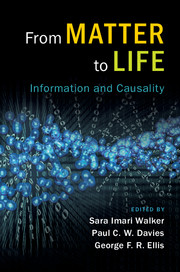Book contents
- Frontmatter
- Contents
- About the authors
- 1 Introduction
- Part I Physics and Life
- Part II Bio from Bit
- 4 (How) Did Information Emerge?
- 5 On the Emerging Codes for Chemical Evolution
- 6 Digital and Analogue Information in Organisms
- 7 From Entropy to Information: Biased Typewriters and the Origin of Life
- Part III Life's Hidden Information
- Part IV Complexity and Causality
- Part V From Matter to Mind
- Index
4 - (How) Did Information Emerge?
from Part II - Bio from Bit
Published online by Cambridge University Press: 02 March 2017
- Frontmatter
- Contents
- About the authors
- 1 Introduction
- Part I Physics and Life
- Part II Bio from Bit
- 4 (How) Did Information Emerge?
- 5 On the Emerging Codes for Chemical Evolution
- 6 Digital and Analogue Information in Organisms
- 7 From Entropy to Information: Biased Typewriters and the Origin of Life
- Part III Life's Hidden Information
- Part IV Complexity and Causality
- Part V From Matter to Mind
- Index
Summary
WAS THERE A TIME BEFORE INFORMATION EXISTED?
Immersed as we are in an ocean of information constantly battering our senses from every possible angle, there can be little doubt of its existence now, but was it always so?
Information comes in many forms. The most obvious is all the explicit information – text, images, video, sound – that appears in the media, in libraries, on the net, in e-mails, on signs, in archives, exchanged in conversations or overheard, searched for, or unsolicited.
But there is also implicit information in body language, in actions taken or not taken, in tone of voice, in the design of everyday objects that suggest purpose, invite or constrain ways of interacting, in smells and tastes and sounds, in geological formations, in fossils, and most of all in all living things – the networks of their interactions, their forms and behaviour patterns, and their internal structure and functions at every scale down to the subcellular, where research in the last few decades has unearthed not only an immense store of implicit biological information in the exquisite structures and processes of life, but also explicitly encoded data in complex information-bearing molecules such as the nucleic acids.
Information can be concrete or intangible, fleeting or durable, meaningful or content free – a passing thought, a privately held idea, a barely perceptible shrug, a conceptual abstraction, a string of random digits, or a literary masterpiece, a film, a beautiful engineering design. Information can also exist at multiple levels; for example, while a message's explicit content may be trivial or misleading, that fact might itself be meaningful. It depends on the receiver's prior information and ability to interpret the message.
In recognising these examples as information, we inevitably consider them from the subjective perspective of observers or receivers of the information and look for the essential aspect of information, that it could convey something, at least in principle. Most of these examples also highlight the dual roles of sources and receivers – generating and sending, on the one hand, and receiving and interpreting the information, on the other. Even in the privacy of one's own mind, it is possible to distinguish the conceiving of an idea and later the recall and recapitulation, revision, or application.
- Type
- Chapter
- Information
- From Matter to LifeInformation and Causality, pp. 61 - 96Publisher: Cambridge University PressPrint publication year: 2017
- 4
- Cited by

